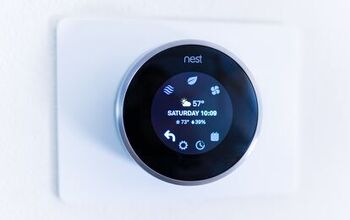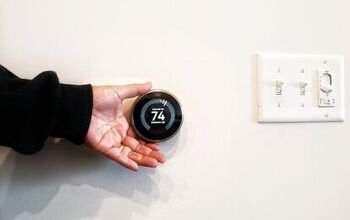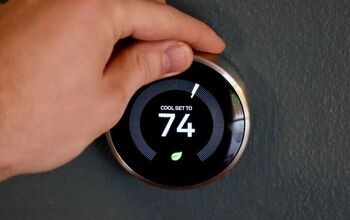Nest Thermostat Not Heating? (Possible Causes & Fixes)

Nest thermostats are great for people who want to have a little extra efficiency. They keep your home warm and nicely climate controlled. However, things don’t always work the way they should. There are going to be times when your Nest thermostat won’t heat up your home. What gives, anyway?
Before you panic, make sure that your Nest thermostat is on, is set to heat, and has batteries in it. Nest thermostats can also have wiring issues that contribute to your heating issues. It’s important to realize that your thermostat may not be the reason your home isn’t heating. Check your HVAC system too!
Being left in the cold can be rough, especially if you are a fan of keeping cozy and hygge in the wintertime. Let’s figure out what’s going on with that thermostat.
Do You Need Your Thermostat Repaired or Reprogrammed?
Get free, zero-commitment quotes from pro contractors near you.

Why Is Your Nest Thermostat Not Heating?
A Nest is supposed to be one of the most reliable thermostats on the market. Unfortunately, this can be caused by a wide variety of different reasons. Let’s talk about the most common ones, ranging from the easy fixes to the harder.
Turn It On
Is your Nest thermostat’s screen dark? Is nothing working? You might not actually have a thermostat that’s turned on. Check to see if it’s on before you panic.
Replace The Batteries
A lot of thermostats, including Google Nest, will start to malfunction when their batteries run low. If your Nest has alerted you to low battery power, this might be why you’re running out of heat. Replace the batteries, reset your Nest, and then check to see how your heat is working.
Check Your Settings
This is step #3 of the “Captain Obvious” portion of your troubleshooter. You need to make sure that your Nest is actually supposed to be heating stuff up. You can do this through the Google Nest app, or you can choose to do it through the thermostat itself.
Raise up the temperature until you see the orange light. If no orange light is present, you may need to take a closer look at your thermostat’s wiring.
Try Soft Resetting Your Thermostat
Resetting your thermostat should fix up most of the problems. This includes having a thermostat that isn’t sending a signal to your heater. Here’s how to do it:
- Push the Nest thermostat ring for 10 seconds.
- Wait until the ring stops lighting up.
- Wait 10 seconds.
- Push the Nest thermostat ring for 10 more seconds to power it up.
Once it boots up, you should see some results in certain cases.
Check Your Heat Link
If your Nest can cool without issue but can’t seem to heat anything up, it could be that your Heat Link is not connected to your thermostat and heater. This means that your thermostat will not be able to send any signals to your heater. Here’s how to fix this:
- For 2nd and 3rd generation Nests, press the Heat Link button once.
- For original Nest thermostats, press the Heat Link button twice.
Check The Wiring
Wiring is vital when it comes to the setup of your Nest device, and the truth is that it’s not the easiest to diagnose. There are several ways that wiring could have caused your Nest to stop sending heat to your home. These issues below can all cause this to happen:
- Your wiring setup is not correct. Did you recently install your Nest? If so, remove the Nest device from the wall and check the wiring. Are the wires actually well connected? If you suspect that your wire went loose or that you didn’t label everything right, you need to re-wire your thermostat and perform a full installation again.
- There is something wrong with the wiring in your house. If you have noticed recent issues with your circuit breaker or have been noticing flickering lights, then your thermostat might not be the issue. Rather, you might have corroded and frayed wires in your home. Now would be a time to call an electrician.
- A recent short caused your circuitry to melt. Yes, this can happen. It’s actually pretty common after extreme storms. If you have reason to believe that your thermostat had a short, you will need to replace your thermostat.
Check Your Fuses
Thermostats have fuses inside their machinery, and that is true for Nests, too. Unfortunately, this is not always going to be easy to do. Unlike with most other thermostats, you are not going to be able to open up your Nest on your own. This is a good time to call a Nest technician.
A Dead Thermostat
It’s always possible that your Nest thermostat could have just up and died. However, you shouldn’t immediately assume that your Nest died. Before you call the company up to get a replacement, check to see if it could be any of the issues below.
How To Fix The Most Common Nest Thermostat Problems
Can It Be Something Other Than Your Thermostat?
Most of the time, you really should take a look at other likely suspects when your thermostat stops heating. These potential issues could also cause a problem.
Your Temperature Sensors Are Obstructed
If your thermostat’s temperature sensors are not working correctly, then you’ll end up getting a potentially higher-than-reality reading. Cleaning the area around the sensor can help you get a more accurate reading.
You Need New Air Filters
Air filters, as I have learned, are the lifeblood of your home’s HVAC system. If your air filters are dirty, hot air can’t go through your vents. If your ventilation is clogged as a result of dirty air filters, then you are going to be unable to get any of the hot air that you’ve signaled for.
What’s worse, you might end up putting your furnace at a risk of overheating. When this happens, your furnace will probably shut down on its own. Thankfully, there is a quick fix here. You will need to replace your air filters to make your thermostat heat your home again.
Your Furnace Is Overheating
Speaking of having a risk of overheating, this is another reason why you might want to hit the pause button. If you notice that your Nest thermostat hit the “heat” function but suddenly shuts off shortly after, then you probably have a furnace that’s getting too hot. This is not something to ignore!
If you have any reason to believe that your furnace is overheating, then you should not even consider turning on the heat. Rather, you should call an HVAC technician to find out what’s going on with your furnace. This is a major safety issue, so don’t delay.
When Should You Call A Professional?
Professional help should be a priority any time that you feel overwhelmed or lost. So, if you don’t feel equipped to troubleshoot this, pick up the phone and call someone. No one will hate you for it. However, there are some moments where it should be a must. These include the following issues:
- You have reason to believe there is a problem with your electrical wiring. This can be a fire hazard, so definitely get on that as soon as you can. In fact, you might want to limit the use of your HVAC until you have gotten things cleared out.
- There’s reason to believe your HVAC system is going haywire. This is also a fire hazard, depending on what’s going on with your system. At the very least, you should consider calling a tech in because of the sheer workload that you have with this diagnostic. Since there are so many elements, it could take hours for an amateur to diagnose things.
- You believe that your Nest thermostat died. If it’s under warranty or during the first trial period, then you might want to call customer service. They’ll happily help you out, or at the very least, direct you to a person who can help. It’s what they do.
Do You Need Your Thermostat Repaired or Reprogrammed?
Get free, zero-commitment quotes from pro contractors near you.

Related Questions
Do furnaces have a fuse?
It depends on the model, but most of the newer furnaces on the market do have a fuse that can potentially blow. If you are unsure whether or not your furnace has a fuse, the best thing you can do is call an HVAC tech who can help you determine what your model does and does not have. It can help cut down on repairs.
How do you manually override Nest’s scheduling?
There are several ways to override Nest’s thermostat scheduling, but the easiest way to do it is from the Nest app. You will need to switch the Nest’s mode from AUTO to MANUAL. From there, you can toggle the different settings, put together your own custom schedule, or start to finagle with the temperature settings as you see fit.
What temperature should I set my Nest to?
If you want to save energy, it’s best to stick to Eco-Mode. This will give you a potential range between 40 to 70 degrees Fahrenheit for heating. If you need to cool down your Nest, you can choose temperatures between 70 to 90 degrees. We suggest keeping it at 60 to 73 degrees.
Related Guide

Ossiana Tepfenhart is an expert writer, focusing on interior design and general home tips. Writing is her life, and it's what she does best. Her interests include art and real estate investments.
More by Ossiana Tepfenhart



























